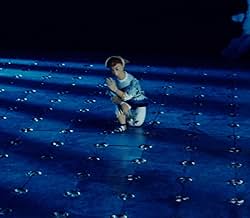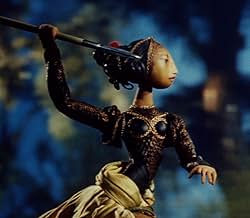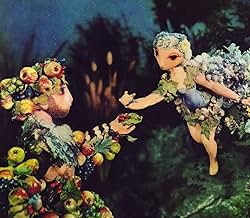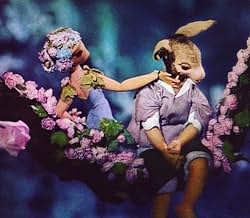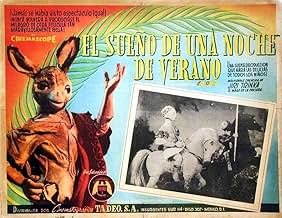The first puppet kinescope in the world. It is based on the famous poetic comedy by William Shakespeare. Three worlds meet in this story: the noble world of three Athens couples, a common po... Read allThe first puppet kinescope in the world. It is based on the famous poetic comedy by William Shakespeare. Three worlds meet in this story: the noble world of three Athens couples, a common popular world of tradesmen amateur theatre and a fairy-tale happiness of magic creatures as ... Read allThe first puppet kinescope in the world. It is based on the famous poetic comedy by William Shakespeare. Three worlds meet in this story: the noble world of three Athens couples, a common popular world of tradesmen amateur theatre and a fairy-tale happiness of magic creatures as elves and nymphs. The film is considered the most remarkable Jirí Trnka's work and a miles... Read all
- Awards
- 1 win & 1 nomination total
- Quince
- (voice)
- Lysander
- (voice)
- Récitant
- (voice)
- …
- Hippolyta
- (voice)
- Oberon
- (voice)
- Titania
- (voice)
- Helena
- (voice)
- Theseus
- (voice)
- Bottom
- (voice)
- Demetrius
- (voice)
- Flute
- (voice)
- Narrator (original Czech version)
- (as R. Pellar)
- Puck
- (voice)
- Egeus
- (voice)
Featured reviews
In his film "The Emperor's Nightingale" the puppets were silent, as actors were silent in the days before talkies. But in "A Midsummer Night's Dream" the puppet's were silent in the way that actors in mime, or ballet dancers are silent.
There was also a basic difference in expression: In the first film the movement was symbolic,in the second, the action was expressed through the language of mime.
All in all... a triumph of stop-motion cinema.
Steve Weber The Laughing Egg Studio
'A Midsummer Night's Dream' is to me one of his best, 'Bajaja' being another favourite, and because of it being such a well known story it is one of his most accessible. A good thing for anybody who had not connected with some of his other films, with some finding some of his films too on the slow side and finding the unfamiliarity of the language being a problem, and yet to see this. 'A Midsummer Night's Dream' is truly great and very enchanting, as well as a very welcome distraction through a difficult time in many ways.
Do agree that the narration doesn't entirely work. Can understand why it was included, to make it accessible for a wider audience, and it is beautifully delivered, but it was pretty talk heavy and interrupted the flow at times. For such a well known story and because the visuals alone tell the story, it wasn't always needed.
However, 'A Midsummer Night's Dream' is a visual masterpiece and one of Trnka's best looking films. The Enchanted Forest backgrounds and the vivid atmosphere the colours evoke make for some of the most beautiful and bordering on miraculous visuals Trnka ever did and the photography enhances them spectacularly. Personally thought that the characters looked fine and not rough or stiff. The music has a nice whimsy and folksy beauty.
Furthermore, the heart, charm, humour and magic of the play are never lost. The humour sparkles, has wit and never comes over crudely, the characters are charming and fun, it is easy to care for the characters' situations and invest in those situations and the magic is in the production design and colourful atmosphere alone. The Pyramus and Thisbe sequence is delightful here and warmed my heart, which is not always the case with this sequence. Any omissions do not harm things at all or make the pace jump about too much.
While the story is a complicated one, it doesn't feel incoherent and despite it being unmistakably Czech it doesn't lose Shakespeare's spirit at the same time. The characters are well delivered and true to character, the funny characters genuinely amuse and are full of personality (without unbalancing things) and the lovers are not passive or personality-free.
Concluding, great and one of Trnka's best. Very fascinating if one wants to see Shakespeare done in a different language and style. 9/10.
In fact, this film is a masterpiece of visual storytelling - a reminder of just how wondrous animation can be when it doesn't insult a viewer's intelligence a la Walt Disney. Indeed, it's surprisingly adult at times. A randy goat (under the influence of magic love potion) tries to rape the fairy Puck. The two runaway lovers, Hermia and Lysander, slip into an eerily vulva-shaped cave to consummate their love. Strange, then, that Trnka cuts out the story's gay element - the desire of the Fairy King Oberon for the changeling boy. Perhaps that was more than Communist-era censors could take.
Otherwise, this is an exemplary reading of the text. Jiri Trnka's visualisation of the Enchanted Forest - every inch of it swathed in moonlight and dripping with rose petals, fairy wings, spying owls - rivals the Baroque splendours of the 1935 Max Reinhardt film. Even the amateur actors' performance of 'Pyramus and Thisbe' (an irksome comic interlude in most stagings) is transformed by Puck's magic into a heart-soaring experience. A must for anyone who loves Shakespeare - or, more important, anyone who doesn't - this is one dream you won't want to wake up from!
David Melville
Animating a human puppet convincingly was always something that Trnka managed to do, but the animation within "A Midsummer Night's Dream" feels a little rough around the edges when compared to the previous work within "Old Czech Legends" (which is still my favorite piece, simply due to the quality of the work, and the odd content).
So in short, don't pass this one up, but you might be slightly disappointed if you're an uber animation nerd. I have only see this work without English captions/voices.
Did you know
- ConnectionsVersion of A Midsummer Night's Dream (1909)
Details
- Release date
- Country of origin
- Official site
- Language
- Also known as
- A Midsummer Night's Dream
- Production company
- See more company credits at IMDbPro
- Runtime1 hour 16 minutes
- Sound mix
- Aspect ratio
- 2.35 : 1
Contribute to this page



